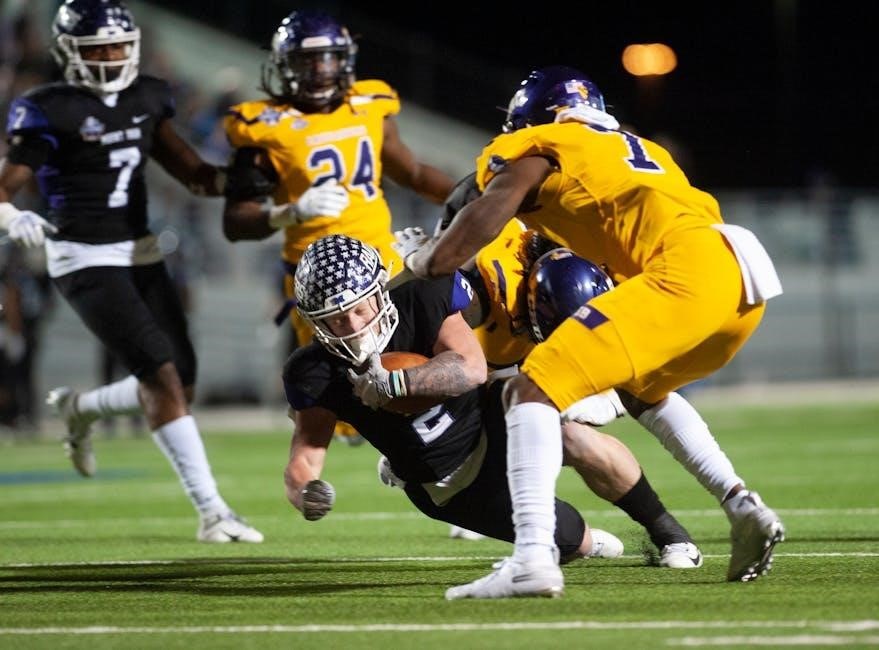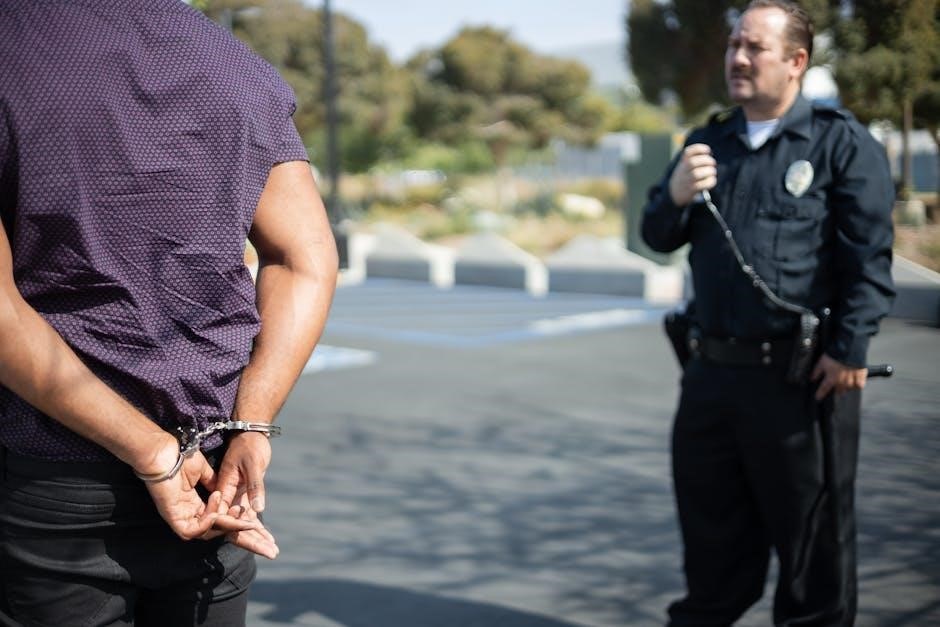The COLREGs (Collision Regulations) are the International Regulations for Preventing Collisions at Sea‚ established in 1972. They provide essential rules for vessel navigation‚ lights‚ shapes‚ and sound signals to ensure maritime safety. The regulations‚ amended over time‚ are crucial for preventing accidents and are enforced globally under the IMO framework.
1.1 Overview of COLREGs and Their Importance
The COLREGs are fundamental international rules designed to prevent maritime collisions‚ ensuring safe navigation for all vessels. By standardizing practices globally‚ they reduce accident risks and enhance communication between ships. Compliance with COLREGs is enforced by the IMO‚ making them indispensable for maritime safety and efficient traffic management at sea.
1.2 Historical Background and Development
The COLREGs were formally established in 1972 under the International Convention‚ with significant amendments in 1977 and 1981. These rules evolved to address maritime safety challenges‚ incorporating advances in technology and navigation practices. The 2018 consolidated version reflects ongoing improvements‚ ensuring the regulations remain effective in preventing collisions and adapting to modern maritime needs globally.
General Provisions of COLREGs
The COLREGs outline fundamental principles for safe maritime navigation‚ applying to all vessels on the high seas and connected waters. They were established in 1972 to standardize international safety practices.
2.1 Application of the Rules
The COLREGs apply to all vessels on the high seas and in waters navigable by seagoing ships. Rule 1(a) specifies their application‚ ensuring uniform safety standards globally. These rules are part of the 1972 Convention‚ amended in 2018‚ and are binding for all ships‚ regardless of flag‚ to prevent collisions and ensure maritime safety.
2.2 Definitions and Terminology
The COLREGs include specific definitions to ensure clarity in their application. Terms like power-driven vessel‚ sailing vessel‚ vessel in sight‚ and restricted visibility are defined to avoid ambiguity. These definitions are crucial for understanding rules related to vessel conduct‚ lights‚ and signals‚ ensuring all mariners interpret the regulations consistently for safe navigation and collision prevention.
Steering and Sailing Rules
This section outlines the rules for vessel conduct in various scenarios‚ ensuring safe maneuvering and collision avoidance. It covers head-on situations‚ overtaking‚ and speed adjustments in reduced visibility to prevent maritime accidents effectively.
3.1 Conduct of Vessels in Sight of One Another
COLREG Rule 14 stipulates that vessels must take necessary actions to avoid collisions when in sight of one another. This includes altering course or reducing speed. Vessels must maintain a safe distance and be prepared to maneuver if a risk of collision arises. Specific guidelines apply to head-on situations‚ overtaking‚ and crossing paths‚ ensuring clear communication and predictable behavior to minimize accident risks at sea.
3.2 Specific Scenarios: Head-on‚ Crossing‚ and Overtaking Situations
In head-on situations‚ vessels must alter course to starboard to avoid collision (Rule 14). When crossing paths‚ the vessel with the other on its starboard must give way (Rule 15). For overtaking‚ the overtaking vessel is responsible for ensuring safe passage (Rule 13). These rules ensure clarity and predictability‚ minimizing collision risks in various navigational encounters.

Lights and Shapes
The COLREGs mandate specific lights and shapes for vessels to ensure visibility and communicate intentions. These signals are critical for safe navigation‚ especially at night or in reduced visibility‚ and vary by vessel type and operational status.
4.1 Requirements for Vessels at Night or in Reduced Visibility
Under COLREGs‚ vessels must display specific lights and shapes at night or in reduced visibility to ensure clear identification and prevent collisions. These include masthead lights‚ stern lights‚ and all-round lights‚ which indicate the vessel’s direction and status. The regulations detail the types‚ colors‚ and placement of these signals to enhance visibility and communication among vessels in low-light conditions.
4.2 Special Signals and Marks for Different Vessel Types
COLREGs require vessels to display specific signals and marks to indicate their type and operational status. Fishing vessels use distinct lights and shapes when engaged in fishing. Tugboats display additional signals when towing. Sailing vessels must show appropriate steaming lights. These special signals enhance identification and safety‚ ensuring clear communication among vessels at sea.

Sound Signals and Their Characteristics
Sound signals are essential for communication between vessels‚ especially in low visibility. COLREGs mandate specific signals‚ like blasts of whistles‚ to indicate maneuvers or situations‚ ensuring safety at sea.
5.1 Mandatory Sound Signals for Collision Avoidance
Mandatory sound signals under COLREGs include whistle blasts used by vessels to communicate intentions. One short blast signals a turn to starboard‚ while two blasts indicate a port turn. Three short blasts warn of reversing engines. These signals are critical for clear communication‚ especially in low visibility‚ to prevent collisions and ensure safe maneuvering at sea.
5.2 Additional Sound Signals and Their Purposes
Additional sound signals include bells‚ gongs‚ and whistles used in specific scenarios. Vessels in restricted visibility must sound a bell and gong combination. Fishing vessels use unique signals to alert others of their operations. These signals enhance communication‚ ensuring clarity in intent and reducing collision risks‚ especially in challenging conditions or when vessels are engaged in specialized activities at sea.
Traffic Separation Schemes
Traffic separation schemes are designated routes for vessels to follow‚ reducing collision risks. Rule 10 governs vessel behavior in these schemes‚ ensuring safe navigation in busy areas.
6.1 Rule 10: Behavior of Vessels in Traffic Separation Schemes
Rule 10 governs vessel behavior in traffic separation schemes‚ ensuring safe navigation. Vessels must stay within designated lanes and avoid crossing traffic unless necessary. Compliance is mandatory‚ with adjustments to speed and course to maintain safety. Fishing vessels and those with limited maneuverability require special consideration. IMO-established schemes aim to minimize collision risks in busy maritime areas effectively.
6.2 Compliance and Safety Measures in Traffic Lanes
Vessels must comply with traffic lane rules to ensure safe navigation. They must follow designated lanes and use navigational aids to maintain course. Deviations require prior notification and safety precautions. Radar and visual monitoring are essential for collision avoidance. Compliance ensures efficient traffic flow and minimizes accident risks‚ fostering a safer maritime environment for all vessels operating within these regulated areas.

Exemptions and Special Cases
Certain vessels‚ like naval ships or fishing boats‚ may be exempt from specific COLREGs under defined conditions. These exemptions are outlined to accommodate unique operational needs while maintaining maritime safety standards.
7.1 Vessels Exempt from Certain Regulations
Certain vessels‚ such as naval ships or those engaged in fishing‚ may be exempt from specific COLREG requirements under particular conditions. These exemptions are granted to accommodate unique operational needs while ensuring safety. For example‚ vessels restricted in their ability to maneuver may receive special considerations. Exemptions are clearly defined to maintain maritime safety without unduly restricting essential operations.
7.2 Special Considerations for Fishing Vessels and Small Crafts
Fishing vessels and small crafts often require special considerations under COLREGs to ensure safe operations. These vessels may display unique lights or shapes to signal their activities. While they must generally comply with COLREGs‚ specific exemptions or adjustments may apply to accommodate their operational needs‚ ensuring both safety and practicality in diverse maritime environments.

Compliance and Verification
Compliance with COLREGs is ensured by flag states and port authorities through regular inspections and certification processes‚ verifying adherence to safety standards and operational requirements at sea globally.
8.1 Enforcement of COLREGs by Flag States
Flag states are responsible for ensuring vessels under their jurisdiction comply with COLREGs. This involves conducting inspections‚ issuing certifications‚ and enforcing penalties for non-compliance. Regular audits and verifications ensure adherence to safety standards‚ while mandatory inspections before certification guarantee vessels meet regulatory requirements‚ maintaining maritime safety and preventing collisions at sea effectively.
8.2 Verification of Compliance Through Inspections and Certificates
Compliance with COLREGs is verified through mandatory inspections and the issuance of certificates. Vessels must undergo regular inspections to ensure adherence to safety standards‚ including proper use of lights‚ shapes‚ and sound signals. Certificates are issued upon successful inspection‚ confirming a vessel’s compliance with the regulations and its readiness for safe operation at sea.
Collision Avoidance Techniques
Collision avoidance relies on radar‚ ARPA‚ and safe speed determination. Proper maneuvering and adherence to COLREGs ensure effective navigation‚ minimizing risks in various maritime scenarios.
9.1 Radar and ARPA (Automatic Radar Plotting Aid) Use
Radar and ARPA systems are critical tools for collision avoidance‚ enabling vessels to detect and track nearby ships. Radar provides real-time positional data‚ while ARPA predicts potential collision risks. Proper use of these technologies ensures safe maneuvering and compliance with COLREGs‚ especially in low-visibility conditions. Regular system checks and crew training are essential for maximizing their effectiveness in preventing maritime accidents.
9.2 Best Practices for Safe Navigation and Maneuvering
Best practices include constant radar and ARPA monitoring‚ maintaining situational awareness‚ and clear communication. Vessels should operate at a safe speed‚ adjust courses early to avoid collisions‚ and ensure compliance with COLREGs. Crews must remain vigilant‚ especially in high-traffic areas or reduced visibility‚ and be prepared to take evasive action when necessary to ensure safe maritime operations.
COLREGs in the Arctic and Environmental Considerations
COLREGs apply globally‚ including Arctic waters‚ ensuring safe navigation amid unique challenges like ice and low visibility. Environmental protection measures are integrated to prevent ecological damage while adhering to collision prevention rules.
10.1 Application of COLREGs in Arctic Waters
COLREGs apply universally‚ including Arctic regions‚ ensuring safe navigation despite unique challenges like ice-covered waters and reduced visibility. Environmental considerations are integrated to protect sensitive ecosystems‚ emphasizing measures to prevent pollution and ecological damage while maintaining collision prevention standards in these vulnerable areas.
10.2 Environmental Impact and Safety Measures
The COLREGs emphasize minimizing environmental impact through measures that reduce pollution and protect marine ecosystems. Specific safety protocols ensure vessels operate responsibly‚ particularly in sensitive areas like Arctic regions‚ balancing collision prevention with ecological preservation to promote sustainable maritime practices and environmental stewardship.
The COLREGs are essential for maritime safety‚ providing standardized navigation rules worldwide. Continuous adherence and updates ensure their effectiveness in preventing collisions and promoting safe sea navigation practices.
11.1 Summary of Key Points
The COLREGs‚ established in 1972‚ provide universal rules for maritime safety‚ emphasizing vessel conduct‚ lights‚ shapes‚ and sound signals. These regulations are regularly updated to address evolving maritime challenges and technologies. Compliance is enforced globally under the IMO framework‚ ensuring standardized practices to prevent collisions and enhance navigation safety for all vessels at sea.
11.2 Future Developments and Updates to COLREGs
The COLREGs are expected to evolve with advancements in maritime technology and environmental concerns. Future updates may address autonomous shipping‚ enhanced safety measures‚ and stricter environmental protections. The IMO will continue to refine the regulations to ensure they remain effective in preventing collisions and adapting to new challenges in international waters.